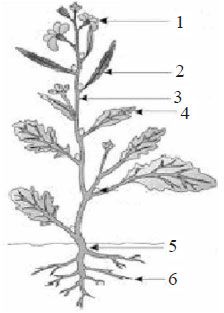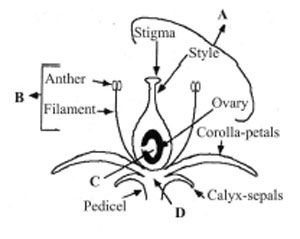Which one of the following characteristics is not related to gynoecium?
It is the female reproductive part of the flower.
It is composed of stamens.
Stigma is usually at the tip of the style and is the receptive surface for pollen grains.
Each ovary bears one or more ovules attached to a flattened, cushion like placenta.
Correct Answer :
B. It is composed of stamens.
Androecium (male whorl) is composed of stamens. Each stamen which represents the male reproductive organ consists of a stalk or a filament or an anther.
Related Questions
Match column - I, II and III and choose the correct option.

A - V, t; B - II, s; C -I, r; D -III, q; E -IV, p
A - I, t; B - II, s; C - III, r; D - IV, p; E - V, q
A - V, p; B - II, s; C - I, q; D - III, r; E - IV, t
A - V, p; B - III, q; C - II, s; D - I, t; E - IV, r
Which of the following is the green expanded part of leaf with vein and veinlets?
Petiole
Node
Stipule
Lamina
Match the following placentation types given in column I with their examples given in column II and choose the correct combination from the options given below.
| (Placentation Types) | (Examples) |
|---|---|
| A. Basal | I. Dianthus |
| B. Free central | II. Pea |
| C. Parietal | III. Lemon |
| D. Axile | IV. Marigold |
| E. Marginal | V. Argemone |
A I, B II, C III, D IV, E V
A II, B III, C IV, D V, E I
A IV, B I, C V, D III, E II
A IV, B III, C V, D I, E II
How many plants in the list given below have marginal placentation?
- Mustard
- Gram
- Tulip
- Asparagus
- Arhar
- Sunhemp
- Chilli
- Colchicine
- Onion
- Moong
- Pea
- Tobacco
- Lupin
Four
Five
Six
Three
Seeds are regarded as products of sexual reproduction because they
can be stored for long time.
are result of fusion of pollen tube.
are result of fusion of gametes.
give rise to new plants.
The mature seeds of plants such as gram and peas, possess no endosperm, because
these plants are not angiosperms.
there is no double fertilization in them.
endosperm is not formed in them.
endosperm gets used up by the developing embryo during seed development.
Identify the inflorescence shown by the given figures A and B.

A-Cymose, B-Racemose
A-Racemose, B-Cymose
A-Racemose, B-Racemose
A-Cymose, B-Cymose
The character of flower which is represented by floral formula but not by floral diagram is
aestivation
placentation
position of gynoecium
adhesion of stamen
Which of the following statements is correct?
Imbricate aestivation is found in papilionaceous family.
Generally sepals are green, leaf like and protect the flowers in the bud stage.
In cymose type of inflorescence, the main axis terminates in a flower, hence is limitless in growth.
In axile placentation ovary is one chambered but it becomes two cambered due to formation of the false septum.
Which one of the following characteristics does not belong to parietal placentation?
Ovules are borne on central axis.
Ovary is one-chambered but it becomes two-chambered due to the formation of false septum.
Examples are mustard and Argemone.
Both (b) and (c)
Which of the following is correct with reference to floral character of family solanaceae?
Racemose, zygomorphic, unisexual, floral characters
Racemose, zygomorphic, bisexual, polypetalous
Axillary, bisexual, actinomorphic, epipetalous
Axillary, actinomorphic, bisexual, epipetalous
The given figure shows the parts of flowering plant. Which parts of the given figure were involved in the following functions:
- Storing reserve food material
- Synthesis of plant growth regulators.
- Absorption of water and minerals from the soil.
- Providing a proper anchorage to the plant parts

5 and 6
1, 2 and 6
1, 2, 3 and 4
2, 4, 5 and 6
During the post-fertilization period, the ovules develops into ___A____ and the ovary matures into a ___B ____.
A - seeds; B - fruit
A - fruit; B - seeds
A - flower; B - seed
A - seeds; B - flower
Root hairs develop from
region of maturation
region of elongation
region of meristematic activity
root cap
Match column-I with column-II and choose the correct option.
| A. Gram, sem, moong, | I. Medicine soyabean |
|---|---|
| B. Soyabean,groundnut | II. Ornamental |
| C. Indigofera | III. Fodder |
| D. Sunhemp | IV. Fibres |
| E. Sesbania, Trifolium | V. Dye |
| F. Lupin, sweet potato | VI. Edible oil |
| G. Mulethi | VII. Pulses |
A I, B II, C III, D IV, E V, F VI, G VII
A VII, B VI, C V, D IV, E III, F II, G I
A II, B IV, C VI, D I, E III, F V, G VII
A I, B III, C V, D VII, E II, F IV, G VI
Read the following statements and answer the question.
- It is the pattern of arrangement of leaves on the stem or branch.
- It is usually of three types - alternate, opposite and whorled.
- It is meant for getting maximum amount of light. statements?
Phyllotaxy
Venation
Inflorescencew
Aestivation
Match the following stem modifications given in column I with their examples given in column II and select the correct combination from the options given below.
| (Stem Modifications) | (Found in) |
|---|---|
| A. Underground stem | I. Euphorbia |
| B. Stem tendril | II. Opuntia |
| C. Stem thorns | III. Potato |
| D. Flattened stem | IV. Citrus |
| E. Fleshy cylindrical stem | V. Cucumber |
A I, B II, C III, D V, E IV
A II, B III, C IV, D V, E I
A III, B IV, C V, D I, E II
A III, B V, C IV, D II, E I
In which of the following plants, a slender lateral branch arises from the base of the main axis and after growing aerially arch downwards to touch the ground?
Mint and jasmine
Banana and pineapple
Grass and stawberry
Pistia and Eichhornia
Which one of the following option shows the correct labelling of the structure marked as A, B, C & D?

A - Gynoecium, B - Megasporophyll, C - Ovule, D - Thalamus
A - Gynoecium, B - Stamen, C - Seed, D - Thalamus
A - Microsporophyll, B - Stamen, C - Ovule, D - Thalamus
A - Gynoecium, B - Stamen, C - Ovule, D - Thalamus
Read the following statements and answer the questions.
- Gynoecium is situated in the centre and other parts of the flower are located on the rim of the thalamus almost at the same level.
- Ovary is half-inferior.
- Examples are plum, rose and peach.
Which condition of flowers is being described by the above statements ?
hypogyny
perigyny
epigyny
none of these
Which of the following statement(s) is/are correct about the fruit?
- Fruit is a mature or ripened ovary, developed before fertilization.
- It consists of a wall or pericarp and seeds.
- When pericarp is thick and fleshy, it is differentiated into outer mesocarp, middle epicarp and the inner endocarp.
- In mango and coconut, the fruit is known as a berry.
Only (i)
Both (ii) and (iii)
Only (ii)
All of these
A scar on the seed coat through which the developing seeds attached to the fruit is called as ________.
testa
tegmen
hilum
micropyle
Aleurone layer helps in
storage of food in endosperm.
protection of embryo.
utilization of stored food.
all of the above.
Pneumatophores are found in
the vegetation which is found in marshy and saline lake.
the vegetation which found in saline soil.
xerophytic condition.
hydrophytic condition.
Matching colmun I with column II and choose the correct option.
| Column I | Column II |
|---|---|
| A. Coleorhiza | I. Grapes |
| B. Food storing tissue | II. Mango |
| C. Parthenocarpic fruit | III. Maize |
| D. Single seeded fruit | IV. Radicle developing from monocarpellary superior ovary |
| E. Membranous | V. Endosperm seed coat |
A III, B I, C IV, D II, E V
A IV, B II, C V, D I, E III
A V, B I, C III, D IV, E II
A IV, B V, C I, D II, E III
Which of the following is a modified stem for the protection of plants from browsing animals?
Tendrils
Thorns
Rhizome
Tuber
The root differs from stem in having
nodes and internodes
axillary buds
multicellular hairs
unicellular hairs
Fibrous roots develop in maize from
upper nodes
lower nodes
upper internodes
none of these
Pollen grains are produced within _________of stamen.
ovary
anther
filament
connective
The given figures (A & B) show two types of compound leaves. Choose the option which identity the correct compound leaf and their example (c).

A - Pinnately compound leaf, C - Neem
A - Palmately compound leaf, C - Neem
B- Pinnately compound leaf, C - Silk cotton
B- Palmately compound leaf, C - Silk cotton
